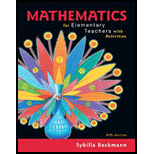
Explain how to use the associative property of multiplication to make 16 .25 easy to calculate mentally. Write equations that show why your method is valid, and show specifically where you have used the associative property of multiplication. Write your equations in the form
Learn your wayIncludes step-by-step video

Chapter 4 Solutions
Pearson eText for Mathematics for Elementary Teachers with Activities -- Instant Access (Pearson+)
Additional Math Textbook Solutions
Basic Business Statistics, Student Value Edition
A First Course in Probability (10th Edition)
Pre-Algebra Student Edition
Elementary Statistics: Picturing the World (7th Edition)
- (1) Let F be a field, show that the vector space F,NEZ* be a finite dimension. (2) Let P2(x) be the vector space of polynomial of degree equal or less than two and M={a+bx+cx²/a,b,cЄ R,a+b=c),show that whether Mis hyperspace or not. (3) Let A and B be a subset of a vector space such that ACB, show that whether: (a) if A is convex then B is convex or not. (b) if B is convex then A is convex or not. (4) Let R be a field of real numbers and X=R, X is a vector space over R show that by definition the norms/II.II, and II.112 on X are equivalent where Ilxll₁ = max(lx,l, i=1,2,...,n) and llxll₂=(x²). oper (5) Let Ⓡ be a field of real numbers, Ⓡis a normed space under usual operations and norm, let E=(2,5,8), find int(E), b(E) and D(E). (6) Write the definition of bounded linear function between two normed spaces and write with prove the relation between continuous and bounded linear function between two normed spaces.arrow_forwardind → 6 Q₁/(a) Let R be a field of real numbers and X-P(x)=(a+bx+cx²+dx/ a,b,c,dER},X is a vector space over R, show that is finite dimension. (b) Let be a bijective linear function from a finite dimension vector ✓ into a space Yand Sbe a basis for X, show that whether f(S) basis for or not. (c) Let be a vector space over a field F and A,B)affine subsets of X,show that whether aAn BB, aAU BB be affine subsets of X or not, a,ẞ EF. (12 Jal (answer only two) (6) Let M be a non-empty subset of a vector space X and tEX, show that M is a hyperspace of X iff t+M is a hyperplane of X and tЄt+M. (b) State Jahn-Banach theorem and write with prove an application of Hahn-arrow_forward(b) Let A and B be two subset of a linear space X such that ACB, show that whether if A is affine set then B affine or need not and if B affine set then A affine set or need not. Qz/antonly be a-Show that every hyperspace of a vecor space X is hyperplane but the convers need not to be true. b- Let M be a finite dimension subspace of a Banach space X show that M is closed set. c-Show that every two norms on finite dimension vector space are equivant (1) Q/answer only two a-Write the definition of bounded set in: a normed space and write with prove an equivalent statement to a definition. b- Let f be a function from a normed space X into a normed space Y, show that f continuous iff f is bounded. c-Show that every finite dimension normed space is a Banach. Q/a- Let A and B two open sets in a normed space X, show that by definition AnB and AUB are open sets. (1 nood truearrow_forward
- can you solve this question and explain the steps used along the wayarrow_forwardcan you solve this question using partial fraction decomposition and explain the steps used along the wayarrow_forwardWhat is Poisson probability? What are 3 characteristics of Poisson probability? What are 2 business applications of Poisson probability? Calculate the Poisson probability for the following data. x = 3, lambda = 2 x = 2, lambda = 1.5 x = 12, lambda = 10 For the problem statements starting from question 6 onward, exercise caution when entering data into Microsoft Excel. It's essential to carefully evaluate which value represents x and which represents λ. A call center receives an average of 3 calls per minute. What is the probability that exactly 5 calls are received in a given minute? On average, 4 patients arrive at an emergency room every hour. What is the probability that exactly 7 patients will arrive in the next hour? A production line produces an average of 2 defective items per hour. What is the probability that exactly 3 defective items will be produced in the next hour? An intersection experiences an average of 1.5 accidents per month. What is the probability that…arrow_forward
- (Nondiagonal Jordan form) Consider a linear system with a Jordan form that is non-diagonal. (a) Prove Proposition 6.3 by showing that if the system contains a real eigenvalue 入 = O with a nontrivial Jordan block, then there exists an initial condition with a solution that grows in time. (b) Extend this argument to the case of complex eigenvalues with Reλ = 0 by using the block Jordan form Ji = 0 W 0 0 3000 1 0 0 1 0 ω 31 0arrow_forwardIntegral How 80*1037 IW 1012 S е ऍ dw answer=0 How 70+10 A 80*1037 Ln (Iwl+1) du answer=123.6K 70*1637arrow_forwardcan you solve this question and explain the steps used along the wayarrow_forward
 Algebra: Structure And Method, Book 1AlgebraISBN:9780395977224Author:Richard G. Brown, Mary P. Dolciani, Robert H. Sorgenfrey, William L. ColePublisher:McDougal Littell
Algebra: Structure And Method, Book 1AlgebraISBN:9780395977224Author:Richard G. Brown, Mary P. Dolciani, Robert H. Sorgenfrey, William L. ColePublisher:McDougal Littell
 Elementary AlgebraAlgebraISBN:9780998625713Author:Lynn Marecek, MaryAnne Anthony-SmithPublisher:OpenStax - Rice University
Elementary AlgebraAlgebraISBN:9780998625713Author:Lynn Marecek, MaryAnne Anthony-SmithPublisher:OpenStax - Rice University Holt Mcdougal Larson Pre-algebra: Student Edition...AlgebraISBN:9780547587776Author:HOLT MCDOUGALPublisher:HOLT MCDOUGAL
Holt Mcdougal Larson Pre-algebra: Student Edition...AlgebraISBN:9780547587776Author:HOLT MCDOUGALPublisher:HOLT MCDOUGAL
 College Algebra (MindTap Course List)AlgebraISBN:9781305652231Author:R. David Gustafson, Jeff HughesPublisher:Cengage Learning
College Algebra (MindTap Course List)AlgebraISBN:9781305652231Author:R. David Gustafson, Jeff HughesPublisher:Cengage Learning





